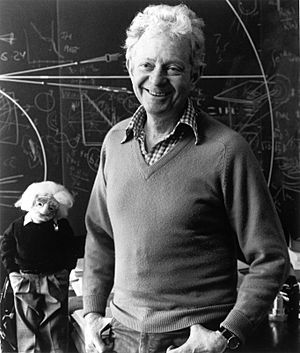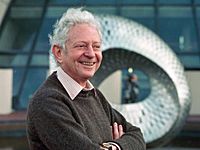Leon M. Lederman facts for kids
Quick facts for kids
Leon M. Lederman
|
|
|---|---|

Lederman in 1988
|
|
| Born |
Leon Max Lederman
July 15, 1922 New York City, New York, U.S.
|
| Died | October 3, 2018 (aged 96) Rexburg, Idaho, U.S.
|
| Education | |
| Known for | Seminal contributions to neutrinos, bottom quark |
| Spouse(s) | Florence Gordon (divorced) Ellen Carr |
| Awards | Nobel Prize in Physics (1988) Wolf Prize in Physics (1982) National Medal of Science (1965) Vannevar Bush Award (2012) William Procter Prize for Scientific Achievement (1991) |
| Scientific career | |
| Fields | Physics |
| Institutions | Columbia University Fermi National Accelerator Laboratory Illinois Institute of Technology |
| Doctoral advisor | Eugene T. Booth |
Leon Max Lederman (born July 15, 1922 – died October 3, 2018) was an American scientist who studied physics. He won the Nobel Prize in Physics in 1988. He shared this award with Melvin Schwartz and Jack Steinberger for their important work on tiny particles called neutrinos.
Lederman also received the Wolf Prize in Physics in 1982. This was for his research on even smaller particles known as quarks and leptons. He was the director of Fermi National Accelerator Laboratory (Fermilab), a famous science lab in Illinois. He also started the Illinois Mathematics and Science Academy in 1986.
He was a great writer about science. His 1993 book, The God Particle, made the term "God Particle" popular for the Higgs boson.
Contents
Early Life and Education
Leon Lederman was born in New York City. His parents were immigrants from Ukraine. He went to James Monroe High School.
After high school, he earned his first college degree from the City College of New York in 1943. Lederman joined the United States Army during World War II. He always planned to become a physicist after the war. In 1946, he left the army and went to Columbia University. He earned his Ph.D. (a very advanced degree) in physics there in 1951.
A Career in Science
Lederman started teaching at Columbia University. He became a full professor in 1958. In 1960, he worked at CERN in Switzerland, which is a major science research center.
In 1979, he took a break from Columbia to become the director of Fermilab. This is a huge laboratory that studies particle physics. He left Columbia and retired from Fermilab in 1989. After that, he taught at the University of Chicago and then at the Illinois Institute of Technology.
Lederman was special because he taught physics to students who weren't even studying physics. He wanted everyone to understand how amazing science is. He also helped lead the "Physics First" movement. This idea suggests that high school students should learn physics before chemistry and biology. He believed this would help students understand science better.
He also supported "Science Debate 2008." This was an effort to get presidential candidates to talk about science issues. Lederman also took part in the "Lunch with a Laureate" program. Here, middle and high school students could talk informally with a Nobel Prize winner.
Discoveries and Research
In 1956, Lederman worked on a concept called "parity violation." This is about how certain tiny particles behave. He and his team quickly confirmed this idea with an experiment.
Among his biggest achievements are two major discoveries. In 1962, he discovered the muon neutrino. Then, in 1977, he discovered the bottom quark. These discoveries showed he was one of the best particle physicists in the world.
In 1977, Lederman's team at Fermilab thought they found a new particle. They called it "Oops-Leon" later because it turned out not to exist. It was a funny mistake in science!
As director of Fermilab, Lederman strongly supported the Superconducting Super Collider project. This was a plan to build an even bigger particle accelerator. He also oversaw the building of the Tevatron at Fermilab. For many years, the Tevatron was the most powerful particle collider in the world.
Lederman wrote his book The God Particle: If the Universe Is the Answer, What Is the Question? in 1993. He wrote it to explain the importance of projects like the Super Collider. He wanted more people to understand the Higgs boson. He wrote that science tries to understand nature by finding a few basic laws and objects.
In 1988, Lederman won the Nobel Prize for Physics. He shared it with Melvin Schwartz and Jack Steinberger. They won for their work on neutrinos and showing how leptons (a type of particle) are structured. Lederman also received many other awards for his amazing contributions to science.
Personal Life
Leon Lederman's friend, Martin J. Klein, helped him see how wonderful physics was. Lederman was known for his great sense of humor among scientists. In 2008, he was filmed on the street answering science questions from people passing by. He answered questions like "What is the strong force?" and "What happened before the Big Bang?".
He had three children with his first wife, Florence Gordon. Later in his life, he lived with his second wife, Ellen Carr, in Idaho.
In 2011, Lederman began to have memory problems. To help pay for his medical care, he sold his Nobel Prize medal in 2015 for $765,000. He passed away on October 3, 2018, at the age of 96, due to complications from dementia.
Honors and Awards
- Elected to the National Academy of Sciences, 1965.
- National Medal of Science, 1965.
- Wolf Prize in Physics, 1982.
- Nobel Prize in Physics, 1988.
- Enrico Fermi Prize of the United States Department of Energy, 1992.
- Vannevar Bush Award, 2012.
- An asteroid, 85185 Lederman, was named in his honor in 1991.
See also
 In Spanish: Leon M. Lederman para niños
In Spanish: Leon M. Lederman para niños
- List of Jewish Nobel laureates


